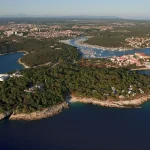As Glas Istre/Boris Zgomba writes on the 1st of November, 2019, the variety of foods, the gastronomic tradition with elements of different cuisines that have historically dominated Croatia and its region over several historical periods and the traditional skill of cooking and eating impresses a large number of guests who visit Istria and Croatia.
Gastronomy is an indispensable part of the experience of a destination and certainly an increasingly important element of the research and interest of modern tourists. The local experience is often associated with enjoying the gastronomic specifics of a particular location. Countries with developed tourist traditions understood this first and as such especially branded their national cuisine.
The best examples globally are countries like France, Italy, Greece and the like. Current global data shows us that currently, the average tourists spend between 20 and 30 percent of their travel budget on food. What we can expect in Istria over the coming period is the further strengthening of the trend of consumption growth to the gastronomic offer.
On the other hand, gastronomy strengthens its influence on the choice of tourist destination. Looking at the latest TOMAS survey by the Institute of Tourism on Attitudes and Tourist Consumption in Croatia, gastronomy and food enjoyment is one of the three main motives for arriving at a destination for as many as 29 percent of tourists.
That is why, when we talk about the development of tourism in general in Croatia, it’s absolutely crucial that we position the country in this segment as much as possible. Croatia’s gastronomic offer, at least on the ground, has a comparative advantage inherent in the Mediterranean climate. As previously mentioned, the variety of food, the gastronomic tradition with elements of different cuisines that have historically dominated the region throughout some periods and the traditional skill of cooking and eating impresses a large number of guests who visit Croatia. What Croatia isn’t excelling in is the communication and presentation of this particular offer to the rest of the world.
Istria is an excellent example of how gastronomy can be transformed into one of the drivers of tourist traffic. In Istria, the branding of gastronomic offer has been very serious for more than a decade now. Istria is a great example of successful synergy between the private and public sectors, working hard and hard to achieve one goal – to brand Istria as the most desirable gastronomic destination in Croatia and the entire Mediterranean. Although we’re still on the way to that goal, we haven’t been without encouraging results.
Today, Istria is the only region in Croatia that has developed an indigenous gastronomic offer in a high quality and systematic way. Numerous private investments in facilities and their offers, as well as numerous activities of the tourist boards, and of course the promotion of travel agencies, which have singled out the gastronomic offer in their programs, helped in this mission.
Tourists, especially from more distant countries such as those from outside of Europe that aren’t part of Croatia’s traditional broadcast markets, are looking for indigenous offers, they want to enjoy the local gastronomy, they want to get informed about local food and drinks, and they want to try their hand at creating them themselves.
Therefore, the popularity of Istria’s gastronomic attractions for tourists, such as indigenous cooking workshops, gastronomic-oriented museums, truffle hunts, numerous events dedicated to local food and days dedicated to the diverse natural produce of Istria from truffles and mushrooms, to cheese and honey, to sausages, prosciutto and much more. Such special offers will be increasingly in demand and they will become the key to generate further tourist demand.
When we talk about gastro tourism, we have to keep in mind that this is a segment of cultural tourism, which is complex and covers many fields of human activity.
Gastronomy best presents the specific lifestyle of a destination, which is why it must be authentic. In order to achieve the national goal that Croatia needs to become a recognisable gastronomic destination and become part of the top twenty tourist destinations in the world, all tourism stakeholders, as well as the wider society, need to “push” in the same direction and encourage the development of a quality offer and its proper presentation.
Make sure to follow our dedicated travel page for much more on tourism in Istria.









